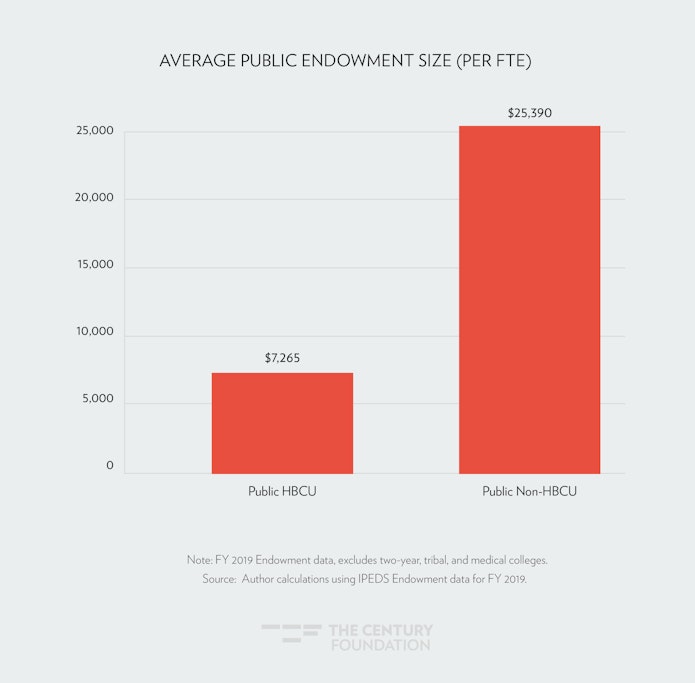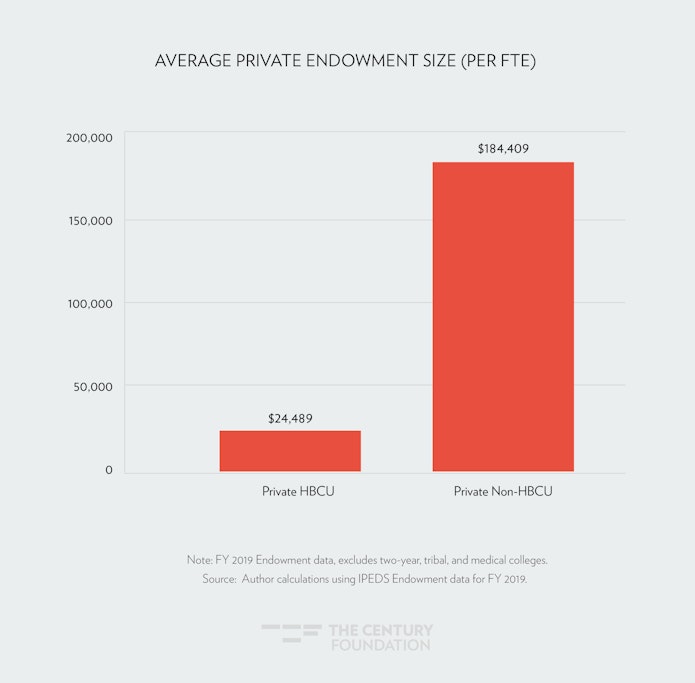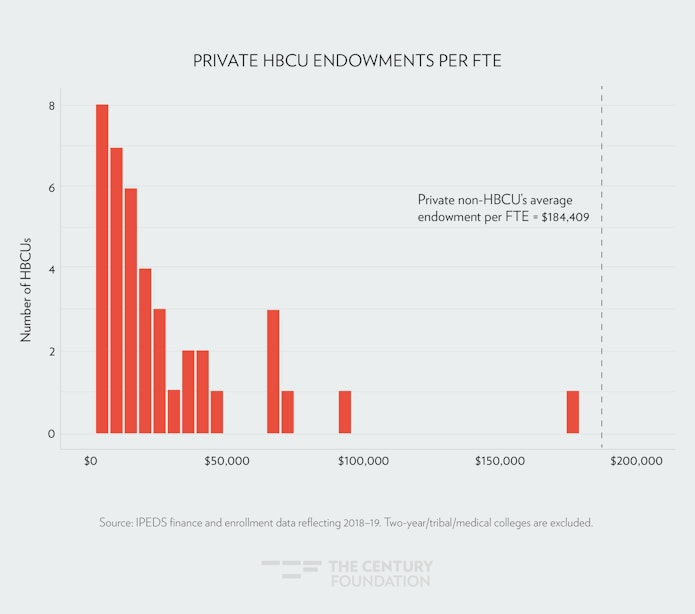Historically Black Colleges and Universities (HBCUs) are having more than a moment, and they are finally getting recognition for the contributions they have made to this country. Their mission has manifested in the development of the next generations of leaders,1 including Vice President Kamala Harris, voting rights activist Stacey Abrams, Senator Raphel Warnock, and White House senior advisor Cedric Richmond, to name a few. HBCUs have always had dynamic faculty to challenge and develop the minds of students, and now we see Howard University continue to build on that legacy with its recent hiring of Nikole Hannah-Jones and Ta-Nehesi Coates. With an increase in enrollment,2 athletic programs hiring former NFL players as football coaches,3 and recruiting top student-athletes,4 the spotlight on HBCUs brings positive press and gifts unlike anything seen in recent years.
HBCUs are engines of upward mobility5 and job creation6 for their graduates, and these recent investments are imperative if the nation is to see progress in racial, social, and economic equity. Yet, many outside the Black community do not know much about these illustrious institutions, how their existence has countered the narrative of White supremacy, and how—despite the effects of discriminatory funding—they have continued to survive for over a century.
A fuller understanding of the history and current financial standing of HBCUs is more important than ever. In the coming months, Congress is expected to consider legislation to invest a trillion dollars in infrastructure, and additional trillions in a Build Back Better plan that, among other things, would support families to be able to afford to enroll7 at community colleges, HBCUs, and Minority-Serving Institutions (MSIs). The plan also proposes additional support for HBCUs, Tribal Colleges and Universities (TCUs), and MSIs to strengthen their academic, administrative, and fiscal capabilities, such as creating or expanding educational programs in high-demand fields (for example, STEM, computer sciences, nursing, and allied health).
Various proposals from legislators and the Biden administration8 are welcome indeed, but given the historic injustices and underinvestment in Black communities specifically and the colleges and universities that serve them, the proposals do not go far enough. Now is the moment for a historic investment that will bring unprecedented resources to HBCUs, giving them the stability and financial independence that will propel them from this moment of recognition to excellence that endures.
This report does not provide the full history of the financial challenges at HBCUs but rather share key historical events that have led to dire inequities in funding to HBCUs, while highlighting the current challenges in funding, and sharing how the proposed higher education investments by the Biden administration can help move the conversation forward and see policy recommendations that close the gap. This report then makes a policy recommendation to ensure HBCUs’ financial stability and continued commitment to academic excellence. More specifically, the federal government should make an unprecedented one-time investment to provide HBCUs with the financial security of a healthy endowment.
Historical Context
For over 150 years, Historically Black College and Universities’ rich legacy pushed the country to address inequalities and strive for a more democratic society. For example, during Reconstruction, when many colleges and universities refused to admit Black men and women because they were deemed inferior, HBCUs provided a pathway to higher learning for African Americans. Despite the grueling challenges formerly enslaved Americans faced from Reconstruction through the Jim Crow era, HBCUs defied the odds, providing African Americans the opportunity to achieve racial uplift, leading to the development of the Black middle class.9 These institutions were founded with a historical mission to educate African Americans, but were not exclusively for African Americans.10 HBCUs have always had talented and diverse faculty11 that help students realize their dreams and change the trajectory of their lives through faculty’s innovative teaching, research opportunities, and mentorship.
While they are often referred to as a collective, HBCUs are not a monolithic group. The 103 institutions were founded by philanthropists, missionary groups, and the African Methodist Episcopal (AME) Church. They also vary in institution type, including two-year and four-year schools, private and public colleges and universities, community colleges, teachers colleges, high-research institutions, medical schools, and open-enrollment institutions (see Map 1 and Table 1). Fifty are private four-year colleges, thirty-nine are public four-year colleges, eleven are two-year public colleges, one is a private two-year institution, and two are medical colleges.
Most HBCUs are in the South, Southeast, and Mid-Atlantic states. Enrollment at individual HBCUs ranges from the hundreds to the thousands, and as a whole they have a total yearly enrollment of around 300,000.12 The communities in which they reside are also diverse, ranging from urban locations in large cities such as Atlanta, Georgia; New Orleans, Louisiana; and Washington D.C., to small cities such as Nashville, Tennessee; Greensboro, North Carolina; and Tallahassee, Florida, to rural communities such as those in Marshall, Texas and Orangeburg, South Carolina. HBCUs graduate students from all socioeconomic strata while also providing first-generation, Pell-eligible, low-income students opportunities to receive an education.
Map 1
Table 1
| Historically Black Colleges and Universities | ||||
| Four-Year Public (39) | Four-Year Private (50) | Two-Year Public (11) | Two-Year Private (1) | Private Medical Schools (2) |
| *Alabama A&M University, Huntsville, Alabama | Allen University, Columbia, SC | Bishop State Community College, Mobile, AL | Shorter College, North Little Rock, AK |
Meharry Medical College, Nashville, TN
|
| Alabama State University, Montgomery, AL | American Baptist College |
Coahoma Community College, Coahoma, MS
|
Morehouse School of Medicine, Atlanta, GA
|
|
| Albany State University, Albany, GA | Arkansas Baptist College |
Denmark Technical College, Denmark, SC
|
||
| *Alcorn State University, Alcorn, MS | Barber-Scotia College |
Gadsden State Community College, Gadsden, AL
|
||
| Bluefield State College, Bluefield, WV | Benedict College, Columbia, SC |
Hinds Community College at Utica, Copiah County, Mississippi
|
||
| Bowie State University, Bowie, MD | Bennett College, Greensboro, NC |
J.F. Drake State Community & Technical College, Huntsville, AL
|
||
| *Central State University, Wilberforce, OH | Bethune-Cookman University, Daytona Beach, FL |
Lawson State Community College, Birmingham, AL
|
||
| Cheyney University of Pennsylvania, Delaware County, PA | Claflin University, Orangeburg, SC |
Saint Philip’s College, San Antonio, TX
|
||
| Coppin State University, Baltimore, MD | Clark Atlanta University, Atlanta, GA |
Shelton State Community College, Tuscaloosa, AL
|
||
| *Delaware State University, Dover, DE | Clinton Junior College, Rock Hill, SC |
Southern University at Shreveport, Shreveport, LA
|
||
| Elizabeth City State University, Elizabeth City, NC | Dillard University, New Orleans, LA |
Trenholm State Community College, Montgomery, AL
|
||
| Fayetteville State University, Fayetteville, NC |
Edward Waters College, Jacksonville, FL
|
|||
| *Florida A&M University, Tallahassee, FL | Fisk University, Nashville, TN | |||
| *Fort Valley State University, Fort Valley, GA |
Florida Memorial University, Miami Gardens, FL
|
|||
| Grambling State University, Grambling, LA | Hampton University, Hampton, VA | |||
| Harris-Stowe State University, St. Louis, MO |
Howard University, Washington, DC
|
|||
| Jackson State University, Jackson, MS |
Huston-Tillotson University, Austin, TX
|
|||
| *Kentucky State University, Frankfort, KY |
Interdenominational Theological Center, Atlanta, GA
|
|||
| *Langston University, Langston, OK |
Jarvis Christian College, Hawkins, TX
|
|||
| Lincoln University (PA), Lincoln University, PA |
Johnson C. Smith University, Charlotte, NC
|
|||
| *Lincoln University of Missouri, Jefferson City, MO | Knoxville College, Knoxville, TN | |||
| Mississippi Valley State University, Itta Bena, MS | Lane College, Jackson, TN | |||
| Morgan State University, Baltimore, MD |
LeMoyne-Owen College, Memphis, TN
|
|||
| Norfolk State University, Norfolk,VA |
Livingstone College, Salisbury, NC
|
|||
| *North Carolina A&T State University, Greensboro, NC | Miles College, Fairfeld, AL | |||
| North Carolina Central University, Durham, NC | Morehouse College, Atlanta, GA | |||
| *Prairie View A&M University, Prairie View, TX |
Morris Brown College, Atlanta, GA
|
|||
| Savannah State University, Savannah, GA | Morris College, Sumter, SC | |||
| *South Carolina State University, Orangeburg, SC | Oakwood College, Huntsville, AL | |||
| *Southern University System, Baton Rouge, LA | Paine College, Augusta, GA | |||
| *Tennessee State University, Nashville, TN | Paul Quinn College, Dallas, TX | |||
| Texas Southern University, Houston, TX |
Philander Smith College, Little Rock, AK
|
|||
| *University of Arkansas at Pine Bluff, Pine Bluff, AK | Rust College, Holly Springs, MS | |||
| *University of Maryland Eastern Shore, Princess Anne, MD | Selma University, Selma, AL | |||
| **University of the District of Columbia | Shaw University, Raleigh, NC | |||
| **University of the Virgin Islands |
Simmons College of Kentucky, Louisville, KY
|
|||
| *Virginia State University, Petersburg, VA |
Southwestern Community College, Terrell, TX
|
|||
| *West Virginia State University, Institute, WV | Spelman College, Atlanta, GA | |||
| Winston-Salem State University, Winston Salem, NC |
St. Augustine’s University, Raleigh, NC
|
|||
| Stillman College, Tuscaloosa, AL | ||||
| Talladega College, Talladega, AL | ||||
| Texas College, Tyler, TX | ||||
| Tougaloo College, Jackson, MS | ||||
|
*Tuskegee University, Tuskegee, AL
|
||||
|
Virginia Union University, Richmond, VA
|
||||
|
Virginia University of Lynchburg, Lynchburg, VA
|
||||
| Voorhees College, Denmark, SC | ||||
|
Wilberforce University, Wilberforce, OH
|
||||
| Wiley College, Marshall, TX | ||||
|
Xavier University of Louisiana, New Orleans, LA
|
||||
| *1890 land grant institutions **1862 land grant institutions |
||||
A History of Public Underfunding
As early as 1871, Black politicians were advocating for the establishment of higher education institutions for Black people. A biracial coalition of Republican leaders in the Mississippi state legislature authorized the purchase of an abandoned White college campus for Black higher education and named it Alcorn University, after the then-governor of Mississippi, James L. Alcorn. Hiram Revels, the first Black man ever elected to the U.S. Senate, would go on to be the institution’s first president. In 1882, Alfred Harris, a freeman and attorney elected to the Virginia legislature, advocated for the establishment of a university for—and run by—African Americans; the proposed bill13 led to the founding of Virginia State University. Similar efforts were attempted by the Black legislatures in other southern states, but the Reconstruction era was short-lived, and the Jim Crow era emerged as White-dominated local and state legislatures sought to maintain White supremacy.
It wasn’t until 1890 that we would see federal legislation specifically supporting Black colleges, through the Agricultural College Act of 1890 (known as the Second Morrill Act).14 This act sought to fund Black higher education institutions (often referred to as 1890 institutions) by including them in the U.S. land grant university system, and thus give Black colleges students access to mechanic- and agriculture-focused curricula.15
While the Second Morrill Act established nineteen public colleges for Black students in seventeen former Confederate states—a much-needed step at the time, considering the limited options Black students had—it also maintained de jure segregation through a “separate but equal” system. Senator Justin Smith Morrill’s intent in proposing the plan was to work toward a truly democratic higher education system, but this approach quickly set the stage for unequal financing of Black higher education.
The mechanism embedded in the Second Morrill Act that led to unequal funding for Black land-grant institutions is the federal–state matching grant. The act declares that these land-grant institutions shall receive an appropriation from the federal government as well as a one-to-one match from the state government. However, over time, some states did not provide this one-to-one match to their 1890 institutions. The state’s refusal meant that the colleges would be punished by having to forfeit the federal portion of the funds as well, unless they sought a waiver from the federal government, which the colleges did.16
Unfortunately, the fight for just and equitable funding for HBCUs extends beyond the land grant system, and has continued throughout their history. This would include the twenty public HBCUs established that do not benefit from the Second Morrill Act funding but that solely depend on state support. Repeatedly throughout the twentieth century, HBCUs would point to the public funding provided to predominantly white institutions and seek redress, but would only occasionally make progress in closing the gap. The period following World War II in particular highlights the disadvantages that HBCUs faced in receiving equitable public funding. The GI Bill, enacted in 1944 to expand access to higher education to veterans, led to increased enrollments at colleges and universities across the nation, which in turn caused trustees and other leadership at these schools to demand increased funding and improved infrastructure from their state legislatures. These post-war surges in enrollment impacted HBCUs differently, however; despite increased enrollment, HBCUs were cut off from state and federal resources provided to predominantly White-serving institutions.17 Without adequate state or private support, HBCUs were not able to expand the campus infrastructure and housing and hire faculty and staff to serve increased demand. As a result, an estimated 20,000 Black veterans seeking a college education were turned away from southern Black colleges, a denial rate double the rate at other colleges.18
The HBCU postwar funding landscape wasn’t entirely bleak, however, as during this period Black intellectuals began taking agency over ensuring Black people could attain higher education. In 1944, for example, Frederick Patterson established the United Negro College Fund (UNCF),19 the first advocacy organization focused on providing aid to Black college students, an effort that would also improve the financial stability of private Black colleges and universities. Now covering thirty-seven member HBCUs, the UNCF is the first cooperative fundraising venture in American higher education history and one of the most well-known charities.
The Higher Education Act of 1965 (HEA) also would usher in additional support for students to access higher education in the form of student loans and what are now known as Pell Grants, which benefited African American students in particular: today, according to UNCF, 70 percent of HBCU students are Pell-eligible.20 (The Pell Grant is one of the most preferred forms of financial assistance since it covers non-tuition costs and prevents a student from accumulating debt.) While many credit the HEA with addressing inequities in higher education, it wasn’t the first incarnation of the HEA that did that.
Targeted help for HBCUs wouldn’t come until 1986, when William Authur “Buddy” Blakey, an HBCU graduate and senate staffer, helped to craft HEA’s Title III Part B.21 Nearly 150 years after the inception of HBCUs, Title III Part B—which authorizes the federal Strengthening Historically Black Colleges and Universities program22—would become a principal source of their funding and establish their official historical designation, defining an HBCU as:
any historically black college or university that was established prior to 1964, whose principal mission was, and is, the education of black Americans, and that is accredited by a nationally recognized accrediting agency or association determined by the Secretary [of Education] to be a reliable authority as to the quality of training offered or is, according to such an agency or association, making reasonable progress toward accreditation.23
Title III Part B provides grant funding to strengthen HBCUs and their physical plants, development offices, endowment funds, academic resources, and student services.
The latter half of the twentieth century would also see political unrest that eventually would lead to some remedy for the history of underfunding HBCUs. Throughout the Civil Rights Era, the student-led protests in the 1960s and 1970s, during which HBCU students and community members advocated for themselves to be reflected in the curriculum, campus leadership as well as equal resources to support their education. This direct action led the NAACP Legal Defense Fund to take these grievances over funding to court in ten states. The Ayers v. Fordice24 and Adams v. Richardson25 cases dragged on for decades, but fifty years later, these cases would result in settlements that underscore the magnitude of historical underfunding of HBCUs, yet fail to truly close the gap.
In 2002, the Ayers case resulted in a settlement of $503 million to three public Mississippi HBCUs over seventeen years—which unfortunately will soon be discontinued. A settlement in Maryland will deliver about $577 million to Morgan State University, Coppin State University, Bowie State University, and University of Maryland Eastern Shore due to historical underfunding.26 A Tennessee legislative committee recently acknowledged the state underfunded Tennessee State University by $150 to $544 million over the past sixty-plus years, failing to meet the state’s obligations under its federal land-grant designation.27
The damage wrought by this history of public underfunding is visible to anyone who looks closely at the landscape of HBCUs. The American Council of Education in 2015 found that, compared to non-HBCUs, both public and private four-year HBCUs experienced steeper declines in federal funding per full-time equivalent (FTE) student between 2003 and 2015, with private HBCUs seeing a 42 percent reduction.28
When reviewing the funding inequities and budget challenges experienced by my own alma mater, South Carolina State University, I found that, for decades, the school—the only land-grant HBCU in the state—has had to fight constantly to keep from closing. In 2015, South Carolina State alumni and current students assembled under the name The Coalition for Equity and Excellence in South Carolina Higher Education and sued the state for underfunding the school and instead funding duplicate programs at non-HBCU institutions that led to a decrease in enrollment at South Carolina State.29 The coalition was able to demonstrate how the state resourced Coastal Carolina, which used to be a junior college, so that it could transform into a comprehensive university that eventually offered similar degrees to South Carolina State in business, foreign languages, and education. Unfortunately, the case was dismissed in 2016. Looking at the state budget appropriation over the past decade, however, highlights the chasm between South Carolina State and another land grant institution, Clemson University, as well as the state’s flagship public institution, the University of South Carolina.30 One item missing from the state budget is the line item for its one-to-one match for 1862 and 1890 institutions. While I was attending South Carolina State University from 2004 to 2008, the campus was bustling with nearly 5,000 students enrolled; today it’s half that. If lawmakers in South Carolina are seeking to starve South Carolina State of funding in an effort to force it to shut down, they seem to be close to their goal.
Even Robust Private Giving Cannot Fill the Gaps
To address financial goals and close public funding gaps, HBCU leadership have developed ambitious fundraising or capital campaigns, many of which have been essential for providing scholarships for students, developing and supporting academic programs, and building HBCU endowments. But even the most successful private fundraising campaigns cannot serve as a replacement for the missing public funding, for several reasons.
HBCU Alumni Give Generously, but It’s Not Enough
HBCU alumni are loyal and give to their alma maters at generous rates. Some institutions have alumni giving on par or higher than even Harvard University. For example, Claflin University, an HBCU in Orangeburg, South Carolina, has an alumni giving rate of nearly 50 percent, and yet their endowment falls into the median range of private HBCUs.31
Across the board, as it turns out, high alumni giving rates do not translate into large endowments at HBCUs. Due to the colleges’ financial needs, alumni gifts are often quickly used for program or capital improvements rather than banked in an endowment. Moreover, high rates of giving to HBCUs does not mean total giving is large. This disparity is not surprising when you consider the reality of household wealth in America. Historically, the household wealth of Black families on average has been far below that of white families, and currently is only one-tenth (the average Black family has $142,5000) of the wealth of white families (average white family wealth is $983,400, a difference of $840,000).32 If anything, the fact that HBCU alumni on average appear to give a greater portion of their household wealth when compared to non-HBCU alumni should be a point of pride.
Philanthropy to HBCUs Can Be Large, but It Is Uneven
Some HBCUs have recently been the recipients of some generous individual philanthropic gifts. In 2020, MacKenzie Scott, novelist, philanthropist, and ex-wife to Jeff Bezos, made multimillion-dollar donations to twenty-two HBCUs.33 Scott’s unrestricted gifts were the first time HBCU leadership was able to decide where the money should go versus the typical approach, when donors dictate how the funds should be used. That same year, Netflix CEO Reed Hastings donated $120 million to Morehouse College, Spelman College, and the United Negro College Fund.34
The donations from Scott, Hastings, and others will make a significant—perhaps game-changing—contribution to these institutions. These success stories spotlighting the benefits received by well-known institutions, however, draw attention away from the fact that many smaller and less famous institutions failed to benefit from any windfall in donations over the past year. Furthermore, while the recent public attention to issues of racial equity has brought a welcome influx of new donations to many HBCUs, this attention is likely to be fleeting, and HBCUs will once again be overlooked.
Another problem with relying on philanthropy to fund HBCUs is that there are two factors that serve as a drag on such giving. The first is that many philanthropists—individuals and organizations alike—hesitate to donate to HBCUs solely based on low alumni giving. As discussed above, some schools do have high rates of alumni giving, but the total of funds raised can be lower than for other colleges. Philanthropists questioning the low levels of alumni fundraising should look more closely, beyond the total number.
The second factor serving as a drag on philanthropy is that the history of public underfunding of HBCUs combined with low or sporadic private giving means that HBCUs have been continually scrambling for funding—which has led to the inaccurate stereotype that such schools are fiscally mismanaged. Research clearly debunks this myth,35 highlighting that there is no difference in fiscal management between public HBCUs and other public colleges and universities. There is less research on the management of private HBCUs, but this may be because they are among the more well-known institutions (Howard, Morehouse, Spelman, Hampton) that tend to bring in more donations annually. This false narrative is damaging, negatively impacting all HBCUs by deterring philanthropy.
In the end, even robust private giving cannot adequately sustain HBCUs.The two largest public HBCUs in the state of Texas—Texas Southern University and Prairie View A&M—have seen decades of discrimination in funding, but even after Prairie View received a $50 million donation from MacKenzie Scott, it will not make up for decades of inequitable public financing.36
Recommendation: Improve HBCU Stability by Increasing Endowments
Increasing the endowments of HBCUs is not really just about the money, it is about investing in the stability and security of these institutions. Much like the wealth gap between Black families and white families, there is an endowment gap between HBCUs and similar but predominantly white-serving institutions, and filling it is a challenge despite recent donations to HBCUs. For example, when reviewing the top 100 college and university endowments in the country, the highest endowed HBCU, Howard University—often ranked in the top 100 universities nationwide—was not in the top 100 for endowment size, but rather was ranked 160.37 Many HBCUs seek to grow their endowments and diversify their assets through leveraging their real estate holdings, but many cannot get in the investment game despite having millions of dollars in the bank. One frequent suggestion has been that HBCUs should begin investing their endowments in financial markets to see more significant returns to support their colleges; however, a recent study found racist practices in the bond market,38 which is yet another systemic barrier to HBCUs, putting them at a disadvantage when investing in their institutions’ future and living out their mission.
Despite having millions in the bank, many HBCUs still lack the capital needed to engage investors and expand their assets. Engaging in partnerships with investment groups could lead to the college reaping benefits; however, some may pose unforeseen problems. An HBCU with an endowment of $20 million may need to put up a significant portion of that, perhaps as much as $10 million, to engage with investment companies to diversify funds. If the bet pays off, then all is well. There is no guarantee, however, and since HBCU leaders’ primary goal is to create a sustainable future for their institutions, they may be unwilling to jeopardize their future by taking such a risk.
Why the focus on endowments? Endowments are vital to the life of an institution, particularly any college that cannot count on ongoing support from a state government. Endowments allow a college or university to make commitments far into the future, provide a higher quality of service, all while knowing that resources to meet those commitments will continue to be available. Endowments provide financial stability39 to an institution, leverage other sources of revenue to offset the cost of tuition for students that cannot afford it, and provide opportunities for innovative research and creativity in teaching. Endowments can include funds that have restrictions on how they can be used, depending on the donor’s wishes. Most donors give based on their interest and not the institution’s needs, expecting the value of their investments to increase over time through a responsible balance between expenditure and reinvestment of its earnings. A healthy endowment has diversified assets that allow a college to make investments in the market, as well as assets that are liquid and accessible to cover improvements to infrastructure, hiring faculty, enhancing programs and services, as well as providing student scholarships. In many cases, HBCUs spend down their endowments in emergencies, such as in the COVID-19 pandemic, when they used funds to make sure their students got home safely, and in some cases, to house students unable to return home for various circumstances.
When reviewing the current status of endowments, The Century Foundation found that the endowments of public and private non-HBCUs were significantly larger than those of public and private HBCUs. (See Table 2.) The endowments per FTE at public non-HBCUs on average were found to be three times the size of public HBCUs. (See Figure 1.) When looking at private institutions, the numbers were even steeper: the size of private non-HBCUs endowments per FTE were seven times the size of private HBCUs. (See Figure 2.)
Table 2
| FY 2019 Endowment Data, Excluding Two-Year/Tribal/Medical Colleges | |||||
| Number of Institutions | Institutions Reporting Endowments | Average of Endowment per FTE | Average of Endowment at FY End | Sum of Endowments | |
| Public HBCUs | 39 | 38 | $7,265 | $29,469647 | $1,119,846,590 |
| Public Non-HBCUs | 1,001 | 580 | $25,390 | $361,991,303 | $209,954,955,891 |
| Private HBCUs | 50 | 45 | $24,989 | $55,180,537 | $2,483,124,177 |
| Private Non-HBCUs | 1,697 | 1,243 | $184,409 | $363,726,662 | $452,112,240,269 |
| Source: Author calculations using IPEDS Endowment data for FY 2019. | |||||
figure 1
In a study of HBCU capital resources, the U.S. Government Accountability Office matched 100 HBCUs with a set of similar non-HBCUs based on sector, size, location, and the highest degree offered. The GAO found that the non-HBCU endowments averaged $410,000 on a per-student basis, compared to $15,000 for the HBCUs.40
This abysmal gap when comparing endowment funds at HBCUs versus non-HBCUs is due to many of the historic events mentioned above, and the systemic racism that has left HBCUs out of opportunities to grow.
The gap in endowments—and the outrage over it—isn’t news. The much-anticipated book by Adam Harris, The State Must Provide, lays out a detailed case of how racism and exclusion have shaped higher education and calling for the endowment of HBCUs.41 Harris posits that elite white colleges should contribute to HBCU endowments since they benefited from the policy of separate but equal.42
figure 2
To get a better picture of endowment status, it is necessary to evaluate the endowments at all HBCUs, public and private. In particular, looking at the private HBCUs, it is necessary to look at not just the well-known, successful ones, but also the lesser-known, but equally important ones. When you break down the endowment of all private HBCUs, the sizable endowment per FTE is actually quite small. Figure 3 shows the distribution of private HBCUs by endowment per FTE. Among private HBCUs, the smallest endowment reported is $1 (Simmons College of Kentucky), and the largest is $693 million (Howard University). The largest endowment per FTE is $3.9 million (Meharry Medical College). HBCUs’ average endowment per FTE is $16,874, but the median HBCU’s endowment per FTE is just $9,143.43
Figure 3
To atone for the racial and economic inequities that have led to the endowment gaps, the Biden administration and Congress should make a major investment in boosting HBCU endowments to levels that provide the schools with real stability, independence, and flexibility.
How much should the federal government allocate to HBCU endowments? High student and parent borrowing for attending HBCUs has been one of the unfortunate impacts of the underfunding of Black colleges combined with the low wealth of Black families and communities. For HBCUs to have large enough endowments to eliminate student and parent debt, they would need an infusion of endowment funds totaling $53 billion.44 But federal policy should not require the colleges to use all of the funds for grant aid that reduces student debt, since the colleges also need to invest in faculty, facilities, and other upgrades. Flexible endowment funding would allow the colleges to provide aid that eases debt burdens of future students, as many other nonprofit and public colleges do.
Congress should commit $40 billion of this $53 billion target, with the additional funds coming through matching funds from states or private sources. The colleges should be provided a foundational infusion, $10 billion or so, based on enrollment alone, without restrictions other than strict enforcement of nonprofit requirements and a guard against state disinvestment. The next tranche of federal funding should be based on a school’s enrollment of low-income students, student and parent debt levels, past track record of alumni support, matching of future donations, and other factors, with expectations that the corpus would be maintained, as most endowments are, except in emergencies. This federal investment of $40 billion is small, when you compare it to the non-HBCU landscape: it is the size of Harvard University’s endowment alone, spread across more than 100 HBCUs.
This funding would send a clear message that the nation is committed to making equity real; make up for the decades of systemic racism, inequities in funding, and inflation; and aid in leveling the playing field by repairing past wrongs while building back better. In addition, this allocation would put HBCUs in a position to plan for their longevity and permanence. Finally, this funding would provide HBCUs with the opportunity to renovate and enhance aging infrastructure on campus, provide much-needed scholarship to students, build departments and programs, hire and retain dynamic faculty, and establish programs and teams to assist with student success and completion. This investment would allow HBCUs to construct the development and fundraising teams to grow their assets long-term.
Reframing the Conversation
As America grapples with addressing inequities caused by the nation’s racist past, part of that conversation needs to include what is owed to the Black community through healthy and robust public funding for HBCUs. We are amid a racial reckoning, resulting in millions in philanthropic donations to support healthy endowment growth at HBCUs. In addition, we are witnessing a recent spike in enrollment that confirms that HBCUs are now—and have always been—a viable option for students seeking higher education. No longer should we be focused on questions about their relevance, but rather we should be highlighting their significant contributions—and making substantial public investment so that HBCUs’ future can be actualized. The present moment is an opportunity for this country to atone for decades of discrimination and restore what is rightfully owed to the Black community and Black colleges.
For me, growing up, attending an HBCU was always the plan. So many people in my family attended HBCUs, and my earliest memories on HBCU campuses were during my formative years, watching my sister and brother move into their dorms at South Carolina State University, attending different homecoming games, football classics with my parents, and my older cousins giving me tours of their campuses. These early experiences engrained a love and a familial connection that I longed for, solidifying an HBCU as the best and only option for me.
As a graduate of a land-grant HBCU, South Carolina State University, and a private HBCU, Morehouse School of Medicine, and currently enrolled at Howard University in their PhD program in higher education leadership and policy studies, I have never been more sure about these decisions in my life. These beloved institutions are where I honed and continue to enhance my leadership skills, which empowered me to be civically engaged, tackle the challenges that I see in my community, and create lasting memories and life-long friendships.
I understand how central these institutions are to the communities in which they reside and the nation. HBCUs are epicenters of excellence that provide a sense of community and rigor to shape and challenge Black minds to reach their fullest potential. HBCUs were built on traditions that foster self-efficacy and support, and these policy recommendations are investments that will ensure that they continue to persevere for generations to come.
Notes
- Travis J. Albritton, “Educating Our Own: The Historical Legacy of HBCUs and Their Relevance for Educating a New Generation of Leaders,” Urban Review 44 (September 2012): 311–31, https://doi.org/10.1007/s11256-012-0202-9.
- Adams, Susan, “Why Applications and Enrollment Are Spiking at Historically Black Colleges,” Forbes, May 13, 2021, https://www.forbes.com/sites/susanadams/2021/05/13/why-applications-and-enrollment-are-spiking-at-historically-black-colleges/?sh=187015dd2897.
- Randall Williams, “NFL Stars Sanders, George and Wheatley Seek HBCU Revival as Coaches,” Sportico, June 29, 2021, https://www.sportico.com/leagues/college-sports/2021/hbcus-sanders-george-wheatley-coaches-1234632960/.
- Eric Mollo, “HBCUs Become More Appealing for High-Profile Athletes,” ABC News Network, March 2, 2021, https://abcnews.go.com/Sports/hbcus-appealing-high-profile-athletes/story?id=76210979.
- Richard V. Reeves and Nathan Joo, “The Contribution of Historically Black Colleges and Universities to Upward Mobility,” Brookings Institution, August 15, 2017, https://www.brookings.edu/blog/social-mobility-memos/2017/01/19/the-contribution-of-historically-black-colleges-and-universities-to-upward-mobility/.
- Chauncey Alcorn, “Major Companies Are Recruiting MORE HBCU Grads than Ever BEFORE, Administrators Say,” CNN, August 12, 2021, https://www.cnn.com/2021/08/12/business/hbcu-recruitment-corporate-america/index.html.
- See the section that ensures that postsecondary education is accessible and affordable for young adults, and that students who enroll are ultimately successful: “Fact Sheet: How the Build Back Better Plan Will Create a Better Future for Young Americans,” The White House, July 22, 2021, https://www.whitehouse.gov/briefing-room/statements-releases/2021/07/22/fact-sheet-how-the-build-back-better-plan-will-create-a-better-future-for-young-americans/.
- Carrie Warick, “Congress Is Weighing 4 College Affordability Proposals; Here Are the Details,” National College Attainment Network, April 29, 2021, https://www.ncan.org/news/563202/Congress-Is-Weighing-4-College-Affordability-Proposals-Here-Are-the-Details.htm.
- See James D. Anderson, The Education of Blacks in the South, 1860–1935 (Chapel Hill: University of North Carolina Press, 2010). Dr. James Anderson provides a thorough history of how Black education was established in the South, highlighting the significance of HBCUs and Black schooling within a political, cultural, and economic context, demonstrating Blacks’ commitment to education.
- Heather Tirado Gilligan, “How historically black colleges helped rescue Jewish refugees,” Washington Post, December 11, 2019, https://www.washingtonpost.com/outlook/2019/12/11/how-historically-black-colleges-helped-rescue-jewish-refugees/.
- Marybeth Gasman, “The Talent and Diversity of HBCU Faculty,” Forbes, July 19, 2021, https://www.forbes.com/sites/marybethgasman/2021/07/19/the-talent-and-diversity-of-hbcu-faculty/?sh=59d242dd4d90.
- “Table 313.20, Fall enrollment in degree-granting historically Black colleges and universities, by sex of student and level and control of institution: Selected years, 1976 through 2018,” National Center for Education Statistics, https://nces.ed.gov/programs/digest/d19/tables/dt19_313.20.asp.
- Normal School: Speech of Mr. A. W. Harris (colored) from Dinwiddie,” Richmond Daily Whig, February 15, 1882, available at the Library of Virginia, Richmond.
- Agricultural College Act of 1890 26 Stat. 417, 7 U.S.C. § 321 https://www.govinfo.gov/content/pkg/COMPS-10284/pdf/COMPS-10284.pdf.
- Shaun R. Harper, Lori D. Patton, and Ontario S. Wooden, “Access and equity for African American students in higher education: A critical race historical analysis of policy efforts,” Journal of Higher Education 80, no. 4 (2009): 389-414.
- Non-federal funds are those made available by the state either through direct appropriation or under any authority (other than authority to charge tuition and fees) provided by the state to an eligible institution to raise revenue, such as gift acceptance authority. “A Looming Crisis for HBCUs? An Analysis of Funding Sources for Land Grant Universities,” National Education Association, n.d., https://www.nea.org/sites/default/files/2021-07/NEA%20CGPS%20Research%20HBCU%20Brief%202.pdf.
- Jelani M. Favors, Shelter in a Time of Storm: How Black Colleges Fostered Generations of Leadership and Activism (Chapel Hill: University of North Carolina Press, 2019), 240.
- Sarah Turner and John Bound, “Closing the Gap or Widening the Divide: The Effects of the G.I. Bill and World War II on the Educational Outcomes of Black Americans,” The Journal of Economic History 63, no. 1 (2003): 145–77, http://www.jstor.org/stable/3132498.
- See “Frederick Douglass Patterson Biography,” United Negro College Fund, https://uncf.org/pages/frederick-douglass-patterson-main.
- “The ‘HBCU Effect,’” The United Negro College Fund, n.d., https://cdn.uncf.org/wp-content/uploads/The-_HBCU-Effect_-_-UNCF.pdf?_ga=2.48861222.121375142.1629222056-1440252579.1618850552.
- “Obituary: William Arthur ‘Buddy’ Blakey,” Diverse Issues in Higher Education, October 14, 2010, https://www.diverseeducation.com/demographics/african-american/article/15089982/obituary-william-arthur-buddy-blakey.
- “Title III Part B, Strengthening Historically Black Colleges and Universities Program,” U.S. Department of Education, https://www2.ed.gov/programs/iduestitle3b/index.html.
- “White House Initiative on Historically Black Colleges and Universities,” U.S. Department of Education, accessed August 9, 2021, https://sites.ed.gov/whhbcu/one-hundred-and-five-historically-black-colleges-and-universities/.
- Ayers v. Fordice, 879 F. Supp. 1419 (N.D. Miss. 1995), https://law.justia.com/cases/federal/district-courts/FSupp/879/1419/2264344/.
- Adams v. Richardson, 356 F. Supp. 92 (D.D.C. 1973) https://law.justia.com/cases/federal/district-courts/FSupp/356/92/1892620/.
- Brian Witte, “Maryland finalizes $577M settlement for HBCU federal lawsuit,” Associated Press, April 28, 2021, https://apnews.com/article/larry-hogan-maryland-lawsuits-legislation-education-d9a76565b03653234200033bed7a5862.
- “‘Theft At A Scale That Is Unprecedented’: Behind the Underfunding of HBCUs,” National Public Radio, May 13, 2021, https://www.npr.org/2021/05/13/996617532/behind-the-underfunding-of-hbcus.
- Krystal L. Williams and BreAnna L. Davis, “Public and Private Investments and Divestments in Historically Black Colleges and Universities,” American Council on Education, January 2019, https://www.acenet.edu/Documents/Public-and-Private-Investments-and-Divestments-in-HBCUs.pdf.
- See “Funding at HBCUs Continues to be Separate and Unequal,” Diverse Issues in Higher Education, May 31, 2015 (updated June 4, 2015), https://www.diverseeducation.com/home/article/15096570/funding-at-hbcus-continues-to-be-separate-and-unequal and “SCSU supporters suing state: Legal action claims S.C. has caused problems via segregated system,” Times and Democrat, February 15, 2015 (updated February 18, 2020), https://thetandd.com/news/local/scsu-supporters-suing-state-legal-action-claims-s-c-has-caused-problems-via-segregated-system/article_30bedb00-b4cc-11e4-8ac5-efaf2f2cc7c0.html.
- “Ten-Year Comparison of State Education Recurring Appropriations FY 2009–10 to FY 2018–19,” South Carolina Commission on Higher Education, https://www.che.sc.gov/Portals/0/CHE_Docs/finance/10YR_Appropriations_2019.pdf?ver=2020-05-19-161249-067.
- “Alumni Giving at Claflin University Sets National Black College Standard,” Claflin University, February 22, 2018, https://www.claflin.edu/news-events/news/2018/02/22/alumni-giving-at-claflin-university-sets-national-black-college-standard.
- Darity, William. “The True Cost of Closing the Racial Wealth Gap,” n.d. https://www.nytimes.com/2021/04/30/business/racial-wealth-gap.html.
- “Multimillion-Dollar Gift From Mackenzie Scott Helps HBCUs Envision What’s Possible,” Diverse Issues in Higher Education, February 15, 2021, https://www.diverseeducation.com/institutions/hbcus/article/15106959/multimillion-dollar-gift-from-mackenzie-scott-helps-hbcus-envision-whats-possible; Elizbeth Redden, “Fairy Godmother for Once-Overlooked Colleges,” Inside Higher Ed, January 4, 2021, https://www.insidehighered.com/news/2021/01/04/mackenzie-scott-surprises-hbcus-tribal-colleges-and-community-colleges-multimillion.
- Isabel Togoh“Netflix CEO Reed Hastings Donates $120 Million To HBCUs: ‘We Hope This Will Help More Black Students Follow Their Dreams,’” n.d. https://www.forbes.com/sites/isabeltogoh/2020/06/17/netflix-ceo-reed-hastings-donates-120-million-to-hbcus-we-hope-this-will-help-more-black-students-follow-their-dreams/?sh=19dad3696e3a.
- Noah D. Drezner and Anubha Gupta, “Busting the Myth: Understanding Endowment Management at Public Historically Black Colleges and Universities,” Journal of Negro Education 81, no. 2 (Spring 2012): 107–20, https://www.jstor.org/stable/10.7709/jnegroeducation.81.2.0107?seq=1.
- Janet Lorin, “Ivy League Star, a Sharecropper’s Child, Revives a Black College But Even a $50 Million Gift Can’t Reverse Generations of State Discrimination,” March 19, 2021, https://www.bloomberg.com/news/features/2021-03-19/ivy-league-star-a-sharecropper-s-child-revives-a-black-college?sref=bnsQWEv5.
- “HBCUs Struggle to Close the Endowment Gap,” Philanthropy News Digest, July 19, 2017, https://philanthropynewsdigest.org/news/hbcus-struggle-to-close-the-endowment-gap.
- David Allen, “Racism in the Bond Market? A Finance Professor Investigates,” LeBow College of Business, January 17, 2019, https://www.lebow.drexel.edu/news/racism-bond-market-finance-professor-investigates.
- “Understanding College and University Endowments,” American Council on Education, 2021, https://www.acenet.edu/Documents/Understanding-College-and-University-Endowments.pdf.
- “Historically Black Colleges and Universities: Action Needed to Improve Participation in Education’s HBCU Capital Financing Program,” U.S. Government Accountability Office, June 26, 2018, Table 3, https://www.gao.gov/products/gao-18-455,
- Adam Harris, The State Must Provide: Why America’s Colleges Have Always Been Unequal—and How to Set Them Right (New York: HarperCollins, 2021), https://www.harpercollins.com/products/the-state-must-provide-adam-harris?variant=33007266791458.
- Anthony Abraham Jack, “Black Colleges, from the Start, Were Given Less and Expected to Do More,” New York Times, August 10, 2021, https://www.nytimes.com/2021/08/10/books/review/state-must-provide-adam-harris.html.
- Medical colleges and two-year colleges are not included in these two stats.
- TCF’s analysis of IPEDS data from 2017–18 indicates undergraduate Stafford (subsidized and unsubsidized) and Parent PLUS loans at HBCUs totaled $1.76 billion. Graduate students borrowed an additional $890 million. Covering all debt would require endowments of $53 billion, assuming a 5 percent annual return.













